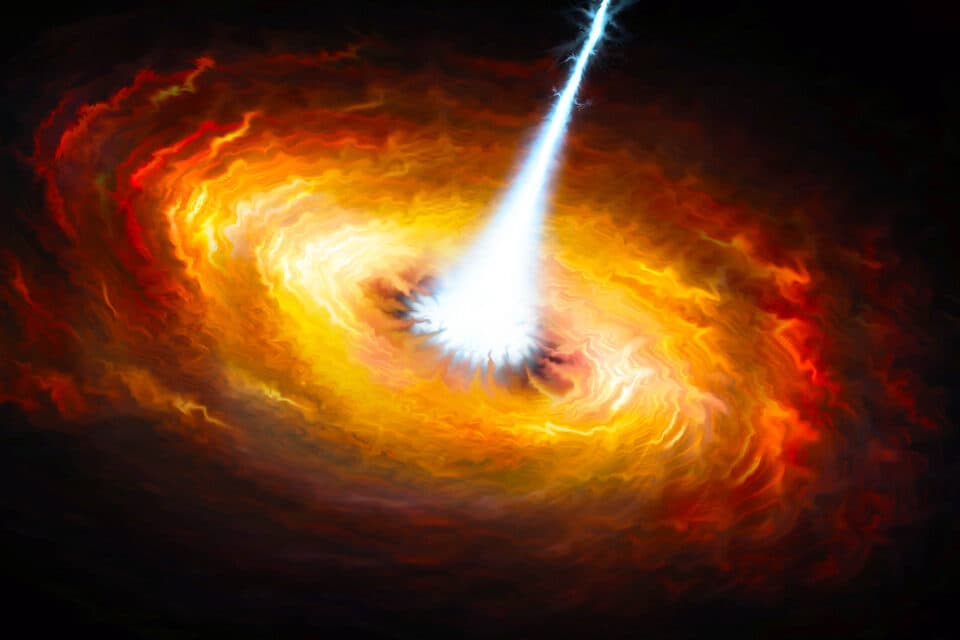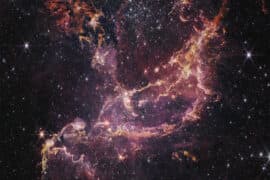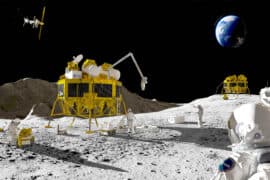
Brightest object ever seen in the universe eats one star per day
Astronomers utilizing the European Southern Observatory’s Very Large Telescope (VLT) have made a brilliant discovery in the cosmos, spotting the brightest quasar ever seen by humans. Quasar J0529-4351 is not only distinguished as the brightest of its kind, but also stands as the most luminous object ever observed in the universe.
Quasars: Beacons of the distant universe
Quasars, the radiant cores of distant galaxies, shine brightly due to the supermassive black holes at their heart. These black holes are not idle; they voraciously consume material from their surroundings, growing in mass daily.
The particular quasar at the center of this discovery is expanding at a remarkable rate, assimilating mass equivalent to one Sun each day, positioning it as the fastest-growing black hole known to science.
The process through which these black holes accrue matter is incredibly energetic, emitting immense quantities of light and rendering quasars as some of the most brilliant entities in our sky. This inherent brightness allows even those quasars located at vast distances to be visible from Earth.
The luminosity of a quasar directly correlates with the growth rate of its supermassive black hole, thus the most luminous quasars harbor the fastest-expanding black holes.
Black hole powers the brightest object ever seen
Christian Wolf, an astronomer at the Australian National University (ANU) and lead author of the study, encapsulated the significance of this discovery.
“We have discovered the fastest-growing black hole known to date. It has a mass of 17 billion Suns and eats just over a Sun per day. This makes it the most luminous object in the known Universe.”
The quasar, designated J0529-4351, is situated so far from Earth that its light has journeyed over 12 billion years to reach us.
The energy emitted by the matter spiraling into this colossal black hole, configured in a disc formation, is staggering. Quasar J0529-4351, the brightest object ever seen by humans, shines over 500 trillion times more luminously than the Sun.
Samuel Lai, an ANU PhD student and co-author of the study, adds, “All this light comes from a hot accretion disc that measures seven light-years in diameter — this must be the largest accretion disc in the Universe.”
To put this into perspective, the disc’s size is about 15,000 times the distance from the Sun to Neptune’s orbit.
Obscurity to spotlight: Journey of quasar J0529-4351
What’s equally astonishing is how this quasar managed to elude detection until now, despite its immense brightness.
“It is a surprise that it has remained unknown until today, when we already know about a million less impressive quasars. It has literally been staring us in the face until now,” shared co-author Christopher Onken, an astronomer at ANU.
Intriguingly, this object appeared in images from the ESO Schmidt Southern Sky Survey as far back as 1980 but was not recognized as a quasar for decades.
The quest to identify quasars involves analyzing vast amounts of observational data, a task often facilitated by machine-learning models. However, these models, trained on existing datasets, may overlook extraordinary objects like J0529-4351, mistaking them for nearer, less significant stars.
It wasn’t until observations from the ANU 2.3-metre telescope at Siding Spring Observatory pinpointed J0529-4351 as a distant quasar. Yet, confirming its status as the most luminous quasar observed required the more powerful X-shooter spectrograph on ESO’s VLT in the Chilean Atacama Desert.
Future of cosmic exploration
This discovery paves the way for further studies with advanced instruments such as the GRAVITY+ upgrade on ESO’s VLT Interferometer (VLTI), which will allow for precise measurements of black holes’ masses, even those located far from Earth.
Moreover, the construction of ESO’s Extremely Large Telescope (ELT) in the Chilean Atacama Desert will enhance our capability to identify and study such elusive cosmic phenomena.
The exploration of distant supermassive black holes offers insights into the early Universe’s mysteries, including the formation and evolution of galaxies.
For Wolf, the motivation is also personal: “Personally, I simply like the chase,” he confesses. “For a few minutes a day, I get to feel like a child again, playing treasure hunt, and now I bring everything to the table that I have learned since.”
Lessons from quasar J0529-4351
In summary, the discovery of the brightest object ever seen in the universe by human eyes, has invigorated the astronomical community.
Quasar J0529-4351, powered by the fastest-growing black hole known, which consumes mass equivalent to one Sun daily, outshines all known objects in the Universe with its black hole amassing 17 billion Suns in mass.
Remarkably, it was overlooked for decades, despite its presence in survey images since 1980, due to the limitations of automated analysis tools.
ESO’s findings challenge current methods of celestial object identification and promise exciting opportunities for future research with advanced instruments like the ESO’s Extremely Large Telescope and the VLT Interferometer’s GRAVITY+ upgrade, potentially unraveling mysteries of the early Universe and its galactic constituents.
—–
Like what you read? Subscribe to our newsletter for engaging articles, exclusive content, and the latest updates.
—–
Check us out on EarthSnap, a free app brought to you by Eric Ralls and Earth.com.
—–












